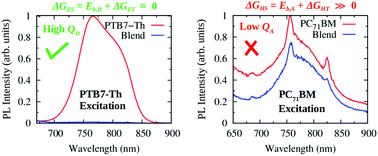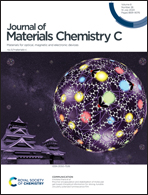Kinetic model for photoluminescence quenching by selective excitation of D/A blends: implications for charge separation in fullerene and non-fullerene organic solar cells†
Abstract
The details of the charge separation kinetics at organic donor/acceptor (D/A) heterojunctions are still poorly understood. Particularly in the field of organic solar cells (OSCs), it is not yet clear why systems with low energetic offsets (driving force, ΔG) between D and A can efficiently dissociate excitons generated in either phase of the heterojunction. This phenomenon has become ubiquitous after the popularization of non-fullerene acceptors (NFAs) to replace the fullerene acceptors (FAs) in efficient OSCs. Here we modeled the kinetics of charge separation at the D/A heterojunctions. The time-dependent concentration of singlet excitons (S1) and charge transfer states (CT) at the D/A interface is quantified by a system of coupled differential equations with transition rates obtained from Marcus/Hush theory. We derived analytical expressions for the exciton quenching produced by selective excitation of the donor (QD) or the acceptor (QA) under the steady-state approximation. We then use this model and quantum chemistry calculations to anticipate the basic features of charge separation in the interfaces of PC71BM and ITIC (FA and NFA) with the PTB7-Th copolymer (D). The model predicts QD = QA = 100% for the system with ITIC and QD = 100% for the system with PC71BM. Yet QA ≪ 100% for selective excitation of PC71BM. This effect is basically produced by the high binding energy of S1 excitons in fullerene. These properties of exciton quenching are in agreement with photoluminescence measurements performed in PTB7-Th/PC71BM (ITIC) blends. With the help of the parameters calculated for these systems and assuming a constant energy for the local S1 state, we found that the magnitude of ΔG determines different mechanisms that limit the exciton dissociation. Singlet exciton recombination is dominant over other recombination channels when ΔG is low. This effect is due to a fast back charge transfer from the CT state to recreate the S1 state population. Nevertheless, direct recombination from the CT state is the dominant channel when ΔG is high. Our analysis may inspire new optimizations strategies to achieve even higher OSC efficiencies.

- This article is part of the themed collection: Celebrating Latin American Talent in Chemistry


 Please wait while we load your content...
Please wait while we load your content...